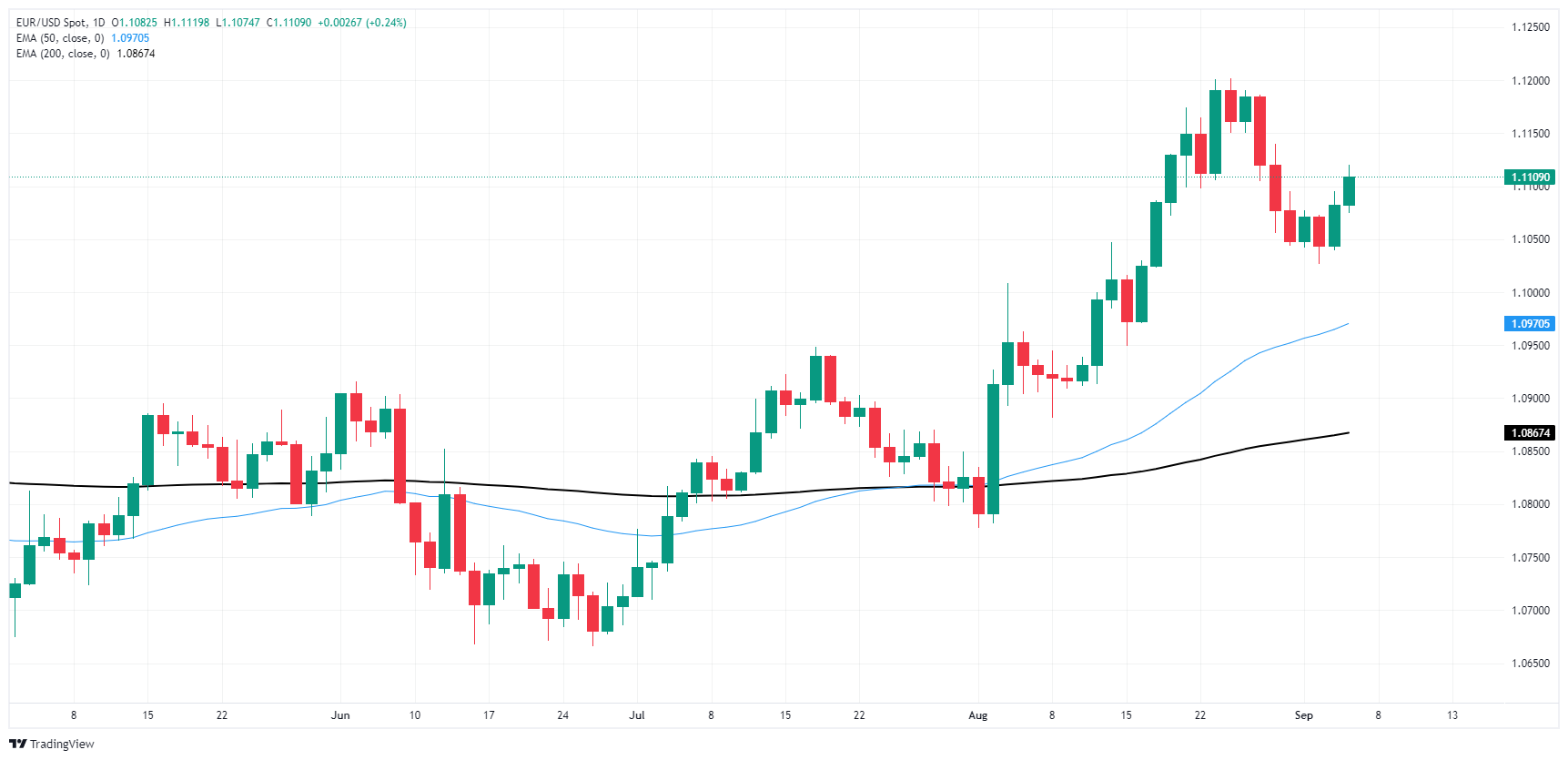- EUR/USD rose on Thursday, climbing back over 1.1100.
- Gains remain limited after miss in EU Retail Sales.
- US NFP print due on Friday takes the center stage for the week.
EUR/USD stepped into a second straight day of gains on Thursday, recapturing the 1.1100 handle as markets broadly sell off the Greenback in advance of Friday’s hotly-anticipated US Nonfarm Payrolls (NFP) jobs report. Markets are looking for further signs that the Federal Reserve (Fed) is on pace to deliver an initial rate trim and kick off a rate cutting cycle in September, but US data will need to continue softening to keep rate cut hopes on the high side.
European economic data did little to provide additional support for the Fiber after July’s EU Retail Sales missed the mark. YoY Retail Sales came in worse than expected, printing at -0.1% for the year ended in July and missing the expected rebound to 0.1% compared to the revised last -0.4% contraction.
According to payroll processor ADP, the US added 99K net new jobs in August, down from July’s revised 111K and well below the expected 145K. August’s ADP additions are the lowest print since early 2021, sparking a fresh round of risk aversion and reigniting investor concerns that the US could be heading into a recession.
The ADP jobs report serves as a bellwether for what markets can expect from Friday’s upcoming US NFP report, albeit one with a wobbly track record for accuracy. August’s NFP print represents the last significant labor update before the Federal Reserve’s (Fed) upcoming rate call on September 18, when Fed policymakers are broadly expected to kick off a rate-cutting cycle. Friday’s NFP print is slated to come in at 160K compared to the previous month’s 114K.
According to the CME, rate markets are currently betting on 40% odds that the Fed will blow the doors open with a 50 bps cut later in the month. The remaining 60% are betting on a more demure 25 bps opening rate trim. Investors are anticipating using this Friday’s NFP print as a way to gauge the depth of the Fed’s first rate cut since the Fed slashed 100 bps in March of 2020.
EUR/USD price forecast
Bidders continue to come out of the woodwork to keep bids on balance even if they can’t quite pull out a bullish recovery. EUR/USD popped into a 13-month high just above 1.1200 early last week, and a near-term pullback in Greenback flows sees bids scrambling to hold onto bullish chart paper.
The pair still trades well north of the 200-day Exponential Moving Average (EMA) at 1.0845. Despite holding deep in the bull country, EUR/USD still faces a steepening bearish pullback as shorts congregate targets just above the 50-day EMA at 1.0956.
EUR/USD daily chart
Euro FAQs
The Euro is the currency for the 20 European Union countries that belong to the Eurozone. It is the second most heavily traded currency in the world behind the US Dollar. In 2022, it accounted for 31% of all foreign exchange transactions, with an average daily turnover of over $2.2 trillion a day. EUR/USD is the most heavily traded currency pair in the world, accounting for an estimated 30% off all transactions, followed by EUR/JPY (4%), EUR/GBP (3%) and EUR/AUD (2%).
The European Central Bank (ECB) in Frankfurt, Germany, is the reserve bank for the Eurozone. The ECB sets interest rates and manages monetary policy. The ECB’s primary mandate is to maintain price stability, which means either controlling inflation or stimulating growth. Its primary tool is the raising or lowering of interest rates. Relatively high interest rates – or the expectation of higher rates – will usually benefit the Euro and vice versa. The ECB Governing Council makes monetary policy decisions at meetings held eight times a year. Decisions are made by heads of the Eurozone national banks and six permanent members, including the President of the ECB, Christine Lagarde.
Eurozone inflation data, measured by the Harmonized Index of Consumer Prices (HICP), is an important econometric for the Euro. If inflation rises more than expected, especially if above the ECB’s 2% target, it obliges the ECB to raise interest rates to bring it back under control. Relatively high interest rates compared to its counterparts will usually benefit the Euro, as it makes the region more attractive as a place for global investors to park their money.
Data releases gauge the health of the economy and can impact on the Euro. Indicators such as GDP, Manufacturing and Services PMIs, employment, and consumer sentiment surveys can all influence the direction of the single currency. A strong economy is good for the Euro. Not only does it attract more foreign investment but it may encourage the ECB to put up interest rates, which will directly strengthen the Euro. Otherwise, if economic data is weak, the Euro is likely to fall. Economic data for the four largest economies in the euro area (Germany, France, Italy and Spain) are especially significant, as they account for 75% of the Eurozone’s economy.
Another significant data release for the Euro is the Trade Balance. This indicator measures the difference between what a country earns from its exports and what it spends on imports over a given period. If a country produces highly sought after exports then its currency will gain in value purely from the extra demand created from foreign buyers seeking to purchase these goods. Therefore, a positive net Trade Balance strengthens a currency and vice versa for a negative balance.
Information on these pages contains forward-looking statements that involve risks and uncertainties. Markets and instruments profiled on this page are for informational purposes only and should not in any way come across as a recommendation to buy or sell in these assets. You should do your own thorough research before making any investment decisions. FXStreet does not in any way guarantee that this information is free from mistakes, errors, or material misstatements. It also does not guarantee that this information is of a timely nature. Investing in Open Markets involves a great deal of risk, including the loss of all or a portion of your investment, as well as emotional distress. All risks, losses and costs associated with investing, including total loss of principal, are your responsibility. The views and opinions expressed in this article are those of the authors and do not necessarily reflect the official policy or position of FXStreet nor its advertisers. The author will not be held responsible for information that is found at the end of links posted on this page.
If not otherwise explicitly mentioned in the body of the article, at the time of writing, the author has no position in any stock mentioned in this article and no business relationship with any company mentioned. The author has not received compensation for writing this article, other than from FXStreet.
FXStreet and the author do not provide personalized recommendations. The author makes no representations as to the accuracy, completeness, or suitability of this information. FXStreet and the author will not be liable for any errors, omissions or any losses, injuries or damages arising from this information and its display or use. Errors and omissions excepted.
The author and FXStreet are not registered investment advisors and nothing in this article is intended to be investment advice.
Recommended content
Editors’ Picks

AUD/USD: Strong resistance lies at 0.6300
The marked sell-off in the US Dollar allowed AUD/USD to regain strong upside traction and reach multi-day highs in the area just below the key 0.6300 barrier at the beginning of the week.

EUR/USD: Bulls need to clear 1.0400 on a convincing fashion
In line with the rest of the risk-associated complex, EUR/USD managed to regain marked buying pressure and flirted with the area of three-week highs around 1.0430 on Monday.

Gold remains focused on all-time highs
Gold stays in positive territory above $2,700 on Monday as the improving risk mood makes it difficult for the US Dollar to find demand. Markets await US President Donald Trump's speech at the inauguration ceremony.

Solana Price Forecast: Are US traders dumping Bitcoin and XRP for SOL?
Solana (SOL) price stabilized near the $250 support level on Monday, having declined 10% from its all-time high over the last 24 hours.

GBP/USD stays defensive below 1.2200, awaits Trump 2.0
GBP/USD struggles to gain traction and trades slightly below 1.2200 in the second half of the day on Monday. Markets' nervousness ahead of US President-elect Donald Trump's inauguration drag the pair lower despite a broadly weaker US Dollar.

Trusted Broker Reviews for Smarter Trading
VERIFIED Discover in-depth reviews of reliable brokers. Compare features like spreads, leverage, and platforms. Find the perfect fit for your trading style, from CFDs to Forex pairs like EUR/USD and Gold.